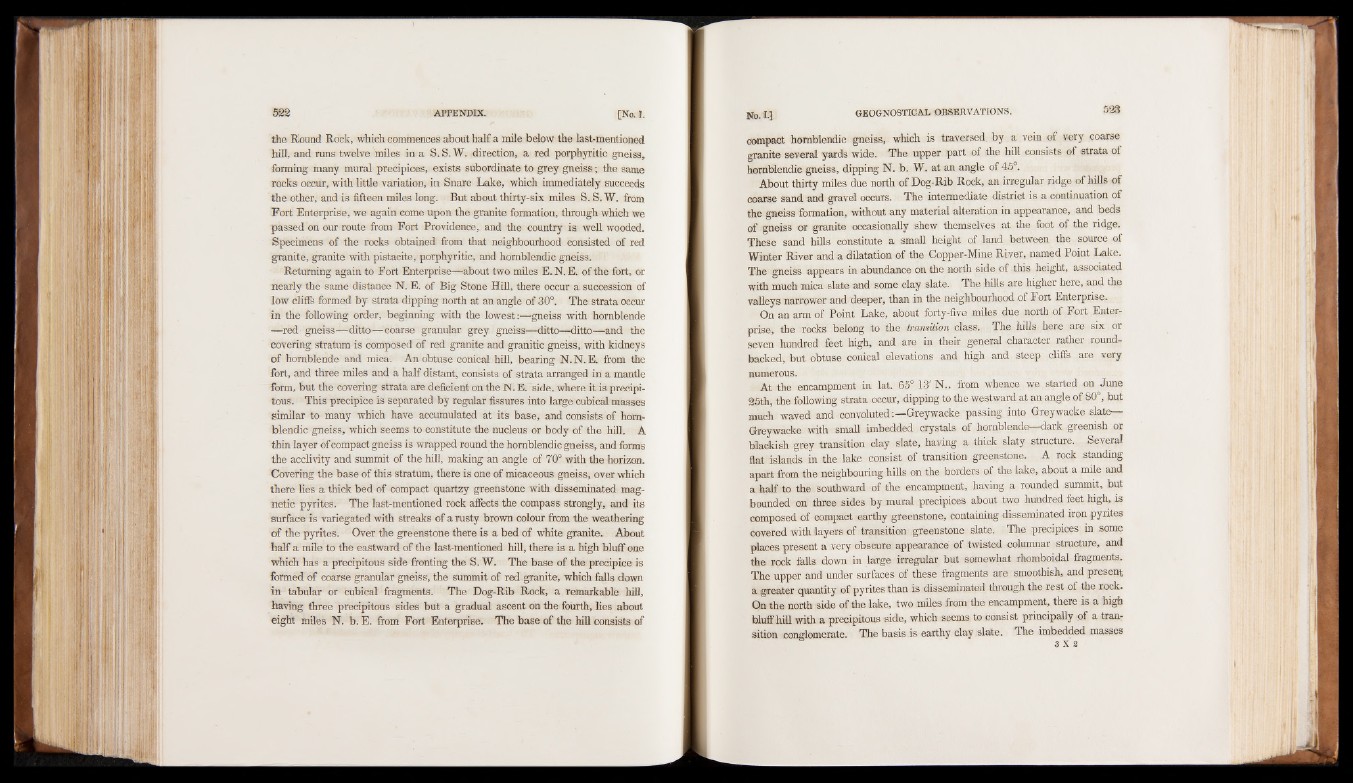
the Round Rock, which commences about half a mile below the last-mentioned
hill, and runs twelve miles in a S. S. W. direction, a red porphyritic gneiss,
forming many mural precipices, exists subordinate to grey gneiss; the same
rocks occur, with little variation, in Snare Lake, which immediately succeeds
the other, and is fifteen miles long. But about thirty-six miles S. S. W. from
Fort Enterprise, we again come upon the granite formation, through which we
passed on our route from Fort Providence, and the country is well wooded.
Specimens of the rocks obtained from that neighbourhood consisted of red
granite, granite with pistacite, porphyritic, and homblendic gneiss.
Returning again to Fort Enterprise—about two miles E.N.E. of the fort, or
nearly the same distance N. E. of Big Stone Hill, there occur a succession of
low cliffs formed by strata dipping north at an angle of 30°. The strata occur
in the following order, beginning with the lowest ;*J-gneiss with hornblende
—red gneiss—ditto—coarse granular grey gneiss—ditto—ditto—and the
covering stratum is composed of red granite and granitic gneiss, with kidneys
of hornblende and mica. An obtuse conical hill, bearing N. N. E. from the
fort, and three miles and a half distant, consists of strata arranged in a mantle
form, but the covering strata are deficient on the N. E. side, where it is precipitous.
This precipice is separated by regular fissures into large cubical masses
similar to many which have accumulated at its base, and consists of homblendic
gneiss, which seems to constitute the nucleus or body of the hill. A
thin layer of compact gneiss is wrapped round the homblendic gneiss, and forms
the acclivity and summit of the hill, making an angle of 70° with the horizon.
Covering the base of this stratum, there is one of micaceous gneiss, over which
there lies a thick bed of compact quartzy greenstone with disseminated magnetic
pyrites. The last-mentioned rock affects the compass strongly, and its
surface is variegated with streaks of a rusty brown colour from the weathering
of the pyrites. Over the greenstone there is a bed of white granite. About
half a mile to the eastward of the last-mentioned hill, there is a high bluff one
which has a precipitous side fronting the S. W. The base of the precipice is
formed of coarse granular gneiss, the summit of red granite, which falls down
in tabular or cubical fragments. The Dog-Rib Rock, a remarkable hill,
having three precipitous sides but a gradual ascent on the fourth, lies about
eight miles N. b. E. from Fort Enterprise. The base of the hill consists of
compact homblendic gneiss, which is traversed by a vein of very coarse
granite several yards wide. The upper part of the hill consists of strata of
homblendic gneiss, dipping N. b. W. at an angle of 45°.
About thirty miles due north of Dog-Rib Rode, an irregular ridge of hills of
coarse sand and gravel occurs. The intermediate district is a continuation of
the gneiss formation, without any material alteration in appearance, and beds
of gneiss or granite occasionally shew themselves at the foot of the ridge.
These sand hills constitute a small height of land between the source of
Winter River and a dilatation of the Copper-Mine River, named Point Lake.
The gneiss appears in abundance on the north side of this height, associated
with much mica slate and some clay slate. The hills are higher here, and the
valleys narrower and deeper, than in the neighbourhood of Fort Enterprise,
On an arm of Point Lake, about forty-five miles due north of Fort Enterprise,
the rocks belong to the transition class. The hills here are six or
seven hundred feet high, and are in their general character rather round-
backed, but obtuse corneal elevations and high and steep cliffs are very
nuAmte rtohues .encampment in lat. 65° 13' N., from whence we started on June
25th, the following strata occur, dipping to the westward at an angle of 80°, but
much waved and convoluted:—Greywacke passing into Greywacke slate—
Greywacke with small imbedded crystals of hornblende dark greenish or
blackish grey transition day slate, having a thick slaty structure. Several
flat islands in the lake consist of transition greenstone. A rock standing
apart from the neighbouring hills on the borders of the lake, about a mile and
a half to the southward of the encampment, having a rounded summit, but
bounded on three sides by mural precipices about two hundred feet high, is
composed of compact earthy greenstone, containing disseminated iron pyrites
covered with layers of transition greenstone slate. The precipices in some
places present a very obscure appearance of twisted columnar structure, and
the rock falls down in large irregular but somewhat rhomboidal fragments.
The upper and under surfaces of these fragments are smoothish, and present
a greater quantity of pyrites than is disseminated through the rest of the rock.
On the north side of the lake, two miles from the encampment, there is a high
bluff hill with a precipitous side, which seems to consist principally of a transition
conglomerate. The basis,is earthy clay slate. The imb8eXdd2ed masses